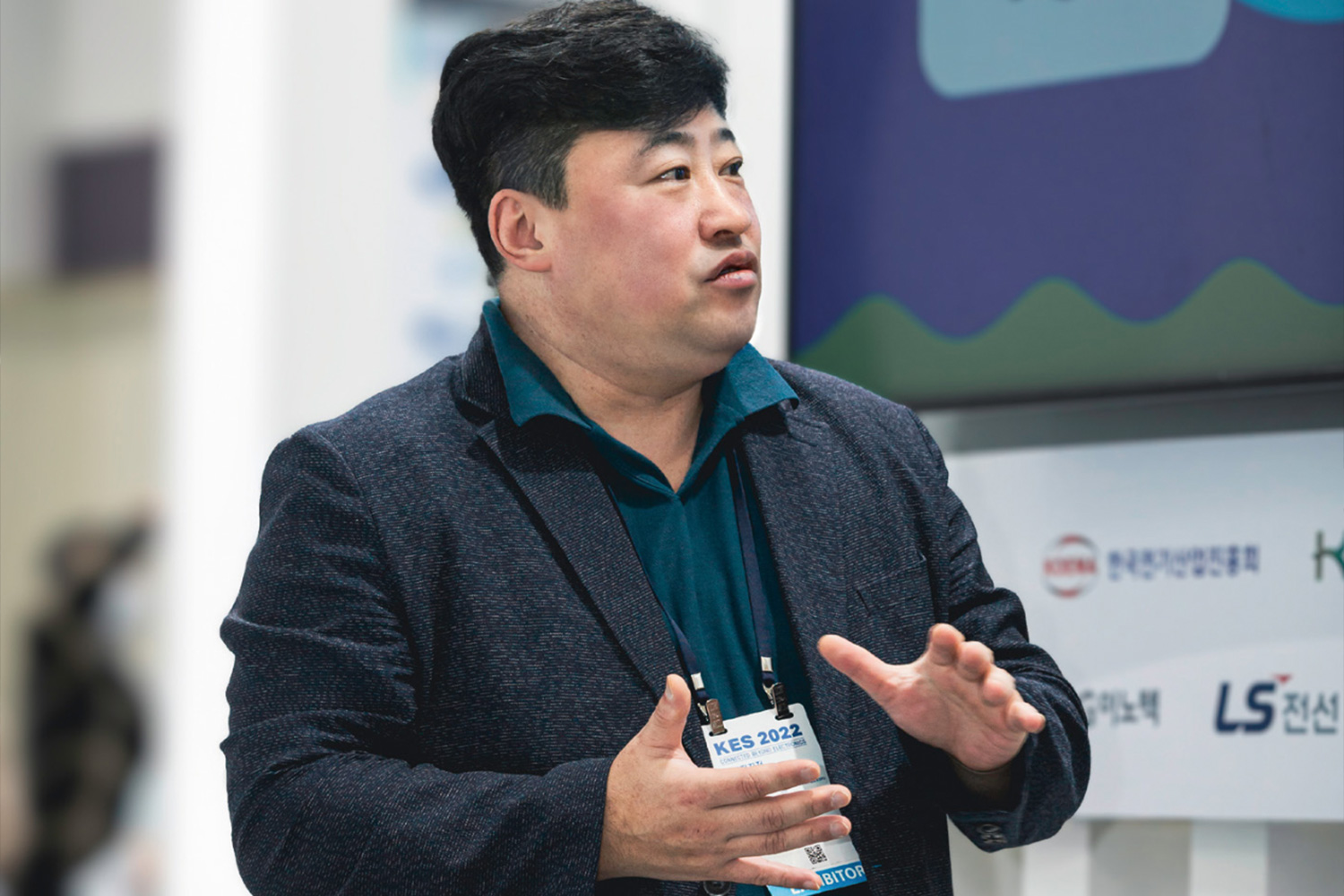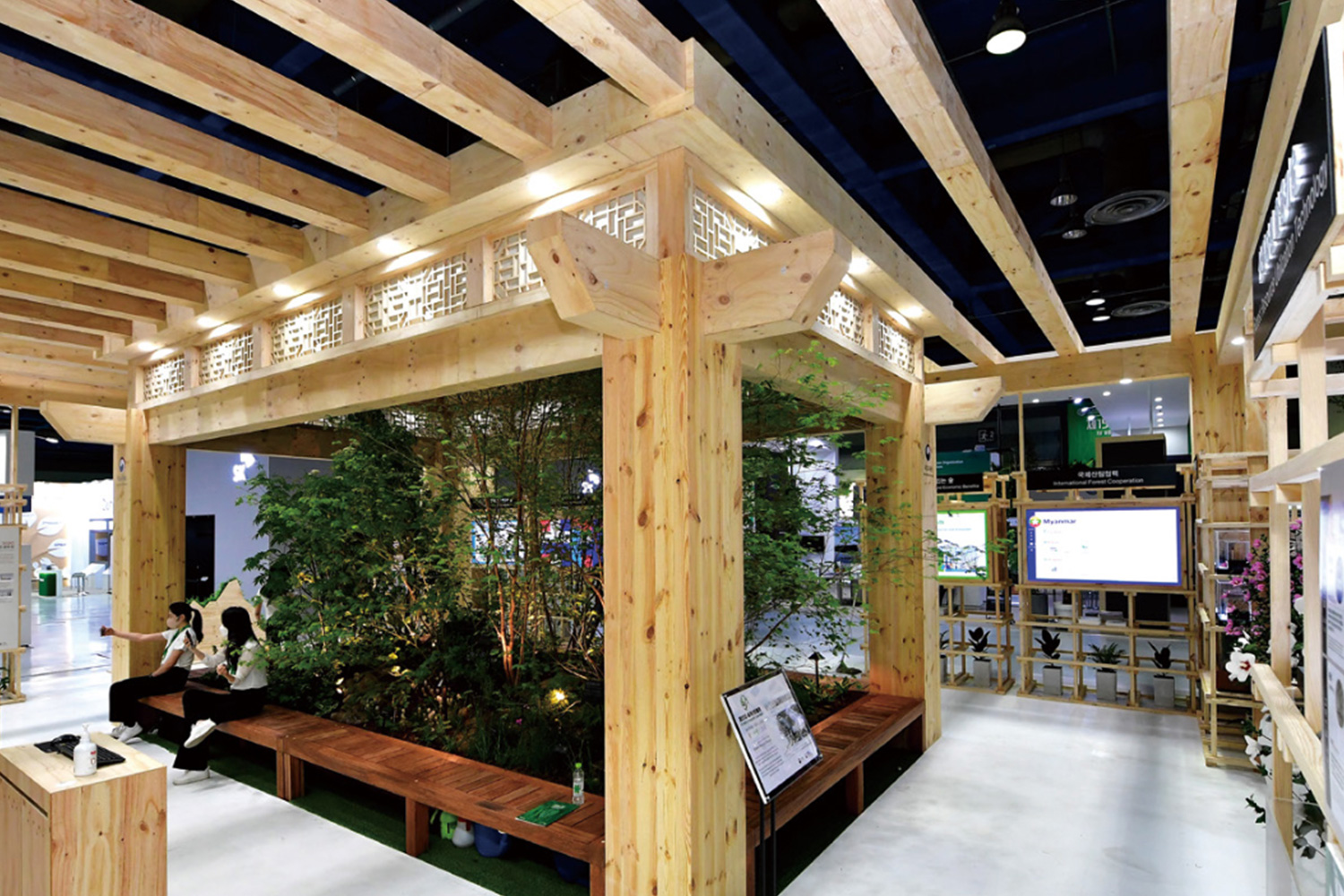
최상규 전무
Sang-gyu Choi (Senior Managing Director)
나라디자인 Naradesign

한국전시디자인 연감 우수작 수상을 축하드립니다. 간략한 본인 소개 부탁드립니다.
우수작을 수상하게 되어 영광입니다. 나라디자인 최상규입니다.
‘제15차 세계산림총회에서 산림청 부스’를 디자인하셨습니다. 산림의 보호와 육성, 산림의 자원과 증식에 관한 업무를 담당하는 산림청을 표현하는 데 고민이 많으셨을 것 같은데요, 이번 부스 디자인의 콘셉트 소개와 이러한 콘셉트를 정한 이유가 궁금합니다.
인위적이지 않고 자연스럽게 산림을 나타낼 수 있는 디자인이 무엇일까 생각하다가 한옥을 떠올리게 되었습니다. 한옥에는 인위적인 조경이 없습니다. 대청마루 뒤로 큰 산이 보이고, 창 하나를 열면 주변의 자연이 그대로 들어옵니다. 한옥 구조 자체가 자연을 그대로 품을 수 있게 설계되어 있죠. 이러한 한옥의 정체성을 이번 전시 디자인에 녹였습니다. 그래서 한옥의 공간을 구현하고 “한옥의 창”이라는 콘셉트로 자연을 대하는 우리의 모습을 담았습니다.
산림의 자원 순환 경제 플랫폼을 나타내기 위해 ‘한옥의 창’을 활용하셨는데요, 산림과 사람의 만남을 나타내는 오브제로도 이용된 것 같습니다. ‘한옥의 창’을 선택하게 된 계기와 이유는 무엇인가요?
창을 열면 주변의 자연을 볼 수 있는 ‘한옥의 창’은 자연을 그대로 순응하며, 사람과 함께 공존합니다. 이것이 산림을 보호하고 육성하는 산림청의 정체성과도 연관되어 있다고 생각했습니다. 창을 통해 무언가를 ‘본다’라는 메시지도 전달하고 싶었습니다. 우리가 창을 통해 보는 것은 현재의 자연일 수도 있고, 과거일 수도 있고, 미래일 수도 있습니다. 자연을 바라보는 우리의 시선을 통해 산림청에 대한 진정성을 느끼게 하고 싶습니다. 전시 부스에서도 안쪽에서 밖을 바라보는 한옥의 시선을 그대로 느낄 수 있게 중앙에 소통할 수 있는 공간인 마루를 설치하고, 밖으로는 자연을 느낄 수 있는 조형물을 설치하여 ‘한옥의 창’을 구현했습니다.
한옥을 구현할 때 가장 중요하게 생각했던 것은 무엇이었나요? 원하는 것을 표현하기 위해 어떤 노력을 기울이셨는지도 궁금합니다.
우리가 원하는 목적에 맞게 한옥을 콘셉트화시키는 일이 가장 중요했습니다. 전시를 디자인하다 보면 실제의 모습을 그대로 옮겨오기가 어렵기 때문에, 단순화하는 작업을 거치게 됩니다. 이번 전시에서도 다양한 한옥의 요소 중 어떤 것을 가져와야 전시의 목적에 맞게 한옥을 구현할 수 있는지를 고민해야 했습니다. 이번 전시 부스에서는 ‘마루와 창’이라는 요소를 통해 안에서 밖을 볼 수 있는 공간을 만들었습니다. 또한, 한옥의 느낌을 자아낼 수 있도록 서까래의 라인만을 디자인하여 상부 구조를 만들었습니다.
부스 디자인을 보며 사람을 통해 보는 자연을 강조한 느낌을 받았습니다. 이번 부스를 통해 보여준 자연은 어떤 의미였나요?
한옥의 처마가 산의 능선과 닮아있듯이 한옥은 인간이 자연에 순응하고자 하는 마음을 담고 있습니다. 이러한 한옥의 특성을 통해 과거 선조의 삶처럼 자연에 순응하고 자연과 함께 공존하는 관계를 보여주고 싶었습니다.
하나의 콘셉트를 정하고, 그것을 디자인으로 구현하는 것이 전시 부스 디자인에서 가장 중요한 것 같습니다. 디자인 아이디어를 얻고, 아이디어를 구현하기 위해 노력하는 것이 있다면 말씀 부탁드립니다.
어떤 이야기를 할지를 정하고 그것에 맞는 콘셉트를 정합니다. 그러기 위해서는 다양한 분야를 공부해야 하죠. 역사나 건축, 미래 기술 등 다방면에 관심을 갖는 것이 좋습니다. 저 역시 관련 책을 많이 읽고 다양한 행사에 참여하려고 노력하고 있습니다. 무엇보다 새로운 것을 받아들이려는 자세가 가장 중요합니다.
마지막으로 전시 부스 디자이너를 꿈꾸는 분들에게 해주고 싶은 이야기와 전시 부스 디자이너로서 갖춰야 할 역량에 대해 조언 부탁드립니다.
미국 존 헤스켓 교수는 “디자인이란 디자인을 만드는 것을 디자인하는 것이다(Design to design a design to produce a design)”라고 정의하였습니다. 창조적인 아이디어는 그냥 나오는 것이 아니라 이미 디자인되어 있는 본질의 의미를 다시 잘 담아내는 과정이라는 뜻입니다. 전시 부스 디자인은 이미 디자인된 것에 또다시 디자인을 덧붙이는 작업입니다. 때로는 동질감 있게, 때로는 이질적으로 목적에 맞는 디자인을 표현해야 하죠. 아이디어는 디자인해야 하는 대상의 본질을 잘 관찰하는 데에서 시작합니다. 대상은 어떤 특징을 가지고 있는지, 이를 통해 무엇을 표현하고 싶은지를 탐구해보는 것이 가장 좋은 훈련이죠.
Congratulations on being chosen for Good Design in the Korea Exhibition Design Annual. Please briefly introduce yourself.
I am deeply honored to receive this award. I am Sang-gyu Choi from Nara Design.
You designed the booth for the Korea Forest Service at the 15th World Forestry Congress. I guess that you had deeply thought about ways to describe the Korea Forest Service that is responsible for the protection and fostering as well as utilization and proliferation of forests. What was the design concept and your reasoning behind it?
I thought hard about the design that would naturally describe forests and came up with the idea of hanok (traditional Korean architecture). Hanok does not entail artificial landscapes. In general, you can find a big mountain behind the daecheongmaru (wooden floor) and enjoy being ensconced in nature when you open a window. The structure of hanok is designed to embrace nature. We decided to express the identity of hanok to our booth design. The space of hanok was created to embody nature under the concept of “hanok window.”
Your concept of ‘hanok window’ expresses the forest-based circular economy as a platform, and it seems that the concept was also used as a symbolic objet d’art to represent the encounter between forests and humans. What led you to decide to apply the concept of ‘hanok window’?
When you open a hanok window, you can see nature right in front of your eyes. Here, the concept of ‘hanok window’ adapts itself to nature to coexist with humans. I thought that this was related to the identity of the Korea Forest Service with the aim of protecting and fostering forests. I also wanted to deliver the message that we ‘look’ into something through the window. What we look through the window could be the nature of today, the past, and the future. I wanted to make people feel the authenticity of the Korea Forest Service through our eyes of looking at nature. In this regard, we installed the wooden floor in the middle as a space for communication while experiencing the viewpoint of hanok from the inside to the outside, and installed a sculpture to embody nature when creating the ‘hanok window.’
What is most important when you visualize hanok architecture? What did you do to express what you want?
Conceptualizing hanok according to the purpose that we want was the most important thing. We often find it difficult to visualize the actual appearance as it is when we prepare the design for exhibition. In such case, we try to simplify the actual features. This time was no different. We had to figure it out which elements should we take among many that constitute hanok to visualize hanok according to the purpose of exhibition. Designing the booth, we created a space where we look out the window from the inside by using wooden flooring and window. Also, we designed rafter lines only to build the upper structure so that it looks like hanok.
It seems that your booth design emphasized nature as seen through the eyes of humans. What does nature mean expressed by the booth?
Hanok contains the desire of people who want to adapt to nature as if its eaves resemble mountain ridges. Based on such characteristics of hanok, I wanted to show the relations that adapt and coexist with nature as our ancestors did.
It appears that deciding a concept and creating it as a design is most important when it comes to exhibition booth design. Is there any special effort to come up with design ideas and implement them?
First thing I do is to decide what kind of story to be delivered and find the concept accordingly. To make this happen, you need to study various areas. Having multidisciplinary interest in various fields such as history, architect, and future technologies, would be best. I try to read books in related areas and attend various events as much as I can. Above all, having an attitude to accept new things is most important.
Lastly, what would you like to say to the many junior designers who are currently dreaming of becoming an exhibition booth designer? Can you also give them some advice on the essential competencies they should have in order to be an exhibition booth designer?
As John Heskett once said, “Design is to design a design to produce a design.” It means that a creative idea does not pop up. Rather, it is to recapture the meaning of essence of something that is designed already. Exhibition booth design is a process of creating another design for something of which design is completed already. It has to look similar or look different according to the purpose. Capturing an idea starts from observing the fundamentals of the design target. Exploring on the characteristics and find out what you want to describe will be the best training methods.

